Just weeks after releasing our ranking of the top ERP failures of all-time, European-based fleet management company LeasePlan announced its massive SAP ERP failure. In this same announcement, the company also announced that it was taking a 100M Euro write-off and pulling the plug on its SAP project.
What went wrong? Like many past failures such as those at Lidl, National Grid, and Haribo, this SAP failure could – and should – have been avoided.

Table of Contents
ToggleOverview of LeasePlan’s SAP ERP Failure
The company’s initial plan was to consolidate its 35 systems across multiple countries into a single instance of SAP S/4HANA. SAP, Oracle, and a number of industry-specific leasing solutions were among the legacy systems to be replaced. HCL Technologies was hired as the SAP systems integrator to help manage the transformation.
Despite high ambitions and an aggressive timeline, the company failed miserably in its attempts to leverage technology to transform the business. The company cited SAP’s “monolithic architecture” as a key reason why it wouldn’t work for its business and is now pursuing a best of breed ERP strategy instead.
Warning signs stemming from LeasePlan’s SAP failure
In conducting research for this article, we found a number of warning signs that should have tipped off the company, its team, and its consultants that this was going to be a very difficult project.
Here are a few of the warning signs, which we found via articles with various quotes from LeasePlan executives touting the merits of the transformation:
- The company was consolidating 35 systems into one, which is typically a Herculean task in and of itself.
- The company failed in a past SAP implementation at one of its affiliates, which took 4 years to implement and another 3 years to “settle down” after go-live.
- The company’s CIO touted its “extremely aggressive plan” for rolling out the new technology, which is typically not a good thing.
- LeasePlan was pursuing a big bang rollout strategy for most countries it operated, which creates a high-risk profile for most organizations.
- The team acknowledged that change management would be difficult, but that they had it under control with a “comprehensive change management” plan.
These are the warning signs that we often testify about in our SAP expert witness work, but they for some reason were not identified or heeded by this particular company. With these and other obvious warning signs in mind, there are a number of lessons that we can all learn from LeasePlan’s SAP ERP failure.

Lesson #1: Consider industry-specific needs and solutions
Fleet leasing is a fairly unique industry. Standard, off-the-shelf ERP systems are less likely to address the variety of distinctive needs of companies in this space.
You may also be in a similar industry. For example, digital transformations are typically more difficult for industries and companies such as these that are unique:
- Financial services
- Complex, engineer-to-order manufacturing
- Utilities and energy
- Any industry with field services
- Fast-changing industries
- Companies that are actively disrupting the status quo in their respective industries
Be skeptical of concepts like SAP’s Model Company, Oracle’s Unified Model, NetSuite’s Suite Success and other ERP software industry hoaxes that may mislead you to unrealistic expectations. Industry best practices baked into software don’t exist. Neither do silver bullet implementation solutions. It is important to plan and execute accordingly.
If you fit into any of the categories above, it is less likely that a single-vendor solution is going to be the best fit for your strategic and operational needs. It is more likely that a best of breed approach with multiple technologies is going to be a more viable option.
Lesson #2: Deploy technology solutions that align with your business model
Digital transformations are too often misaligned with an evolving business model and overarching corporate strategy. It is nearly impossible to succeed in this type of situation.
Not only was LeasePlan in a unique industry, but it was also actively disrupting its industry with new platforms such as CarNext.com and its Car-as-a-Service business models. This entrepreneurial spirit and new ways of doing business are typically not playing to the strengths of S/4HANA. This misalignment likely created problems during the transformation.
It is important that you understand your business model and define how your digital transformation or project will support that bigger-picture strategy. If you don’t see or don’t define the connection for the rest of your team, then you’re not ready to be starting a large-scale transformation. You have bigger fish to fry in the meantime.
Lessons #3: Remember that you are in control of your project – not your ERP systems integrator!
Perhaps the biggest lesson here for all of us is that we are control of our own digital transformations. If our ERP implementation fails, then it’s our fault. If it succeeds, it’s probably due to decisions we made and actions we took – not because we hired a magical systems integrator that was able to make the project succeed for us.
Things will always start to drift and get off track. That’s a normal part of complex business transformations like these. But the key is how we identify risks, mitigate risks, and take action when warranted.
That could mean firing our systems integrator before we are $100M in the hole. It could mean that we pivot on our strategy when we see that the original plan isn’t working. Or it could mean that we divert resources from technical workstreams so we can double-down on our organizational change management strategy.

In conclusion…
Whatever is needed, take control of your project and do what you need to do to be successful. Learned helplessness is a root cause of many ERP failures.
Our team has helped manage many successful ERP implementations, recover failures, and testified in court when things have gotten too far out of hand. I am happy to share some of these lessons with you and your team, so please feel free to contact me if you would like an informal sounding board on how to avoid some of the mistakes outlined here. I’m happy to help!





